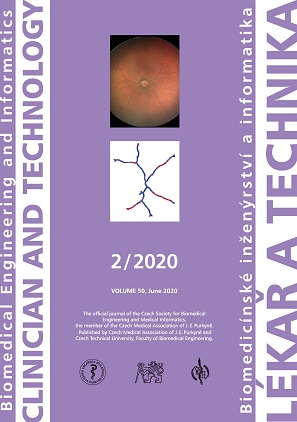THE EFFECT OF FOOTWEAR TO THE POSTURE
DOI:
https://doi.org/10.14311/CTJ.2020.2.03Keywords:
high heels, flat shoes, postural stability, posture, posturology, silhouette posture analysisAbstract
The aim of this study is to assess the effect of footwear on postural status of a group of volunteers representing the general population of female students. Based on the assumption that the elegant shoe with tapered toe and high heel does not provide adequate foot support, the study was designed to assess its direct link and impact to body segment alignment and resulting negative effect on posture. Repetition of this misalignment ensures the individual circumstances of posture. Due to the heel elevation, the weight is transferred to the distal part, resulting in a postural response of the entire musculoskeletal system to maintain balance. The group consisted of 30 women of the age 18–28 years with an average age of 22.7 years, height 167±0.3 cm and weight 57±0.9 kg. Anamnesis and aspection were performed to assess of the occurrence of shortened and weakened muscles and subsequently the patient's standing was examined. Two static methods were chosen for evaluation of the posture. The first one was the Silhouette Posture Analysis and the evaluation method by Jaros and Lomnicka. The result was the identification of typical muscle imbalance as the most common presumption of faulty posture, and it was confirmed that footwear affects a person's natural posture. Differences in the sensitivity of the two methods were also identified and studies are not only appropriate that but also evaluate differences in impact among subjects.
Downloads
Published
Issue
Section
License
Copyright (c) 2021 Marianna Trebuňová, Mária Danko, Lucia Bednarčíková, Monika Michalíková, Jozef Živčák

This work is licensed under a Creative Commons Attribution 4.0 International License.
Authors who publish with this journal agree to the following terms:
- Authors retain copyright and grant the journal right of the first publication with the work simultaneously licensed under a Creative Commons Attribution License (https://creativecommons.org/licenses/by/4.0/) that allows others to share the work with an acknowledgment of the work's authorship and initial publication in CTJ.
- Authors are able to enter into separate, additional contractual arrangements for the non-exclusive distribution of the journal’s published version of the work (e.g., post it to an institutional repository or publish it in a book), with an acknowledgment of its initial publication in this journal.
- Authors are permitted and encouraged to post their work online (e.g., in institutional repositories or on their website or ResearchGate) prior to and during the submission process, as it can lead to productive exchanges.
CTJ requires that all of the content of the manuscript has been created by its respective authors or that permission to use a copyrighted material has been obtained by the authors before submitting the manuscript to CTJ. CTJ requires that authors have not used any copyrighted material illegally, as for example a picture from another journal or book, a photo, etc. It is the author’s responsibility to use only materials not violating the copyright law. When in doubt, CTJ may ask the authors to supply the pertinent permission or agreement about the use of a copyrighted material.
The opinions expressed in CTJ articles are those of authors and do not necessarily reflect the views of the publishers or the Czech Society for Biomedical Engineering and Medical Informatics.


